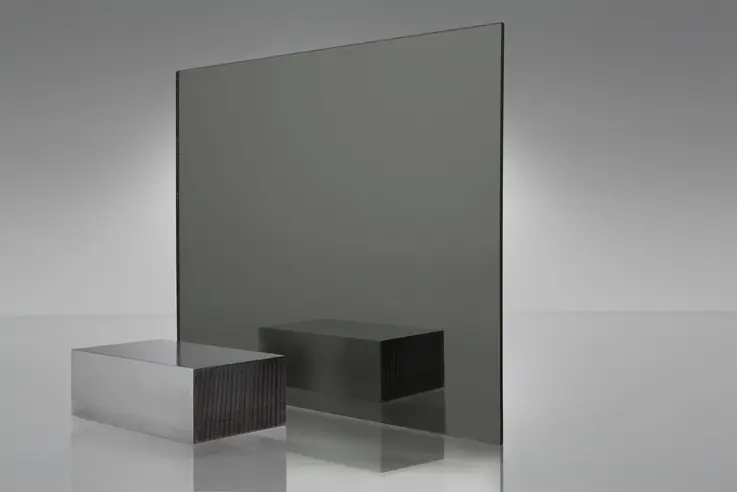In the world of interior design, there are countless ways to add style and sophistication to a space. One popular trend that has been gaining momentum is the use of smoked mirror textures. These unique mirrors offer a touch of elegance and intrigue, making them a perfect addition to any room. In this article, we will explore the process of creating smoked mirror textures, their history, and the modern techniques used in their production.
What is a Smoked Mirror Texture?
A smoked mirror texture refers to a mirror that has been treated with a special coating to create a smoky or hazy effect on the glass surface. This effect is achieved by applying a reflective substance, such as silver, to the glass. The result is a mirror with a slightly tinted or darkened appearance, giving it a unique and sophisticated look.
The Process of Creating Smoked Mirror Textures
The process of creating smoked mirror textures involves coating a non-conductive substrate, usually glass, with a reflective substance. The most common reflective substance used is silver, but other metals can also be used. The substrate is first prepared by cleaning and treating the glass surface to ensure proper adhesion of the reflective coating.
There are two main methods used to create smoked mirror textures: back-silvering and front-silvering. Back-silvering, also known as second-surface silvering, involves applying the reflective coating to the back side of the glass. This method provides protection to the reflective layer from corrosion, scratches, and other damage. However, it may cause some distortions and optical aberrations due to refraction and multiple reflections.
Front-silvering, or first-surface silvering, is the preferred method for precision optical mirrors. In this process, the reflective layer is applied directly to the front surface of the glass, allowing for maximum reflectivity and minimizing distortions. A protective transparent overcoat is often applied to prevent oxidation and scratching of the metal.
History of Smoked Mirror Textures
The use of reflective surfaces dates back to ancient times. In Ptolemaic Egypt, small glass mirrors were backed with lead, tin, or antimony. However, the purpose of these coatings was not to create mirrors but rather for decorative and cosmetic purposes.
The production of tin-coated mirrors began in Europe in the 15th century. These mirrors, known as tain mirrors, were made by applying a thin layer of tinfoil to the glass. It wasn't until the 16th century that glass mirrors started to be silvered with an amalgam of tin and mercury.
In the 19th century, German chemist Justus von Liebig developed a process for depositing silver on the rear surface of glass, which significantly improved the quality and durability of mirrors. This technique was further refined by chemist Tony Petitjean, making it easier and more widely adopted.

In the 20th century, the introduction of vacuum deposition processes allowed for the production of highly uniform and precise coatings. Aluminum became the preferred reflective material for precision optical instruments such as telescopes, due to its high reflectivity and resistance to oxidation.
Modern Techniques for Smoked Mirror Textures
Modern techniques for creating smoked mirror textures involve a combination of electroplating, chemical deposition, and vacuum deposition. Electroplating is used to deposit a thin layer of conductive material, such as carbon, onto the non-conductive substrate. Chemical deposition can improve adhesion between the metal and the substrate, while vacuum deposition allows for precise control of the coating thickness.
Silver is still commonly used for creating smoked mirror textures, especially for household mirrors. The glass is treated with tin chloride to enhance the bonding between silver and glass. A protective layer of copper may also be added for long-term durability.
For precision optical instruments, such as telescopes, aluminum is the preferred reflective material. The glass is placed in a vacuum chamber, and aluminum is evaporated onto the surface. The thin aluminum oxide layer that forms on the surface provides protection and maintains the reflectivity of the underlying aluminum.
Infrared instruments often use gold for their reflective coating. Gold has the highest reflectivity in the infrared spectrum and is highly resistant to oxidation and corrosion.
Smoked mirror textures offer a unique and elegant touch to any space. The process of creating these mirrors involves applying a reflective coating to a glass substrate, resulting in a smoky or hazy effect. The history of smoked mirror textures dates back centuries, with advancements in technology and materials leading to the development of modern techniques. Whether it's for decorative purposes or precision optical instruments, smoked mirror textures continue to captivate and enhance the beauty of interior design.
If you want to know other articles similar to Smoked mirror textures: adding elegance to interior design you can visit the Textures category.

